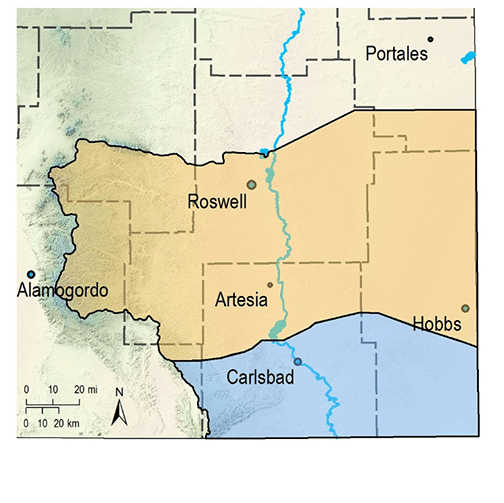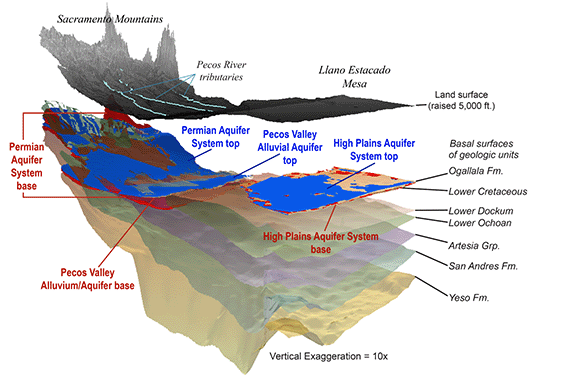Bureau of Geology modeling Delaware Basin aquifers in SE New Mexico
August 19, 2020
SOCORRO, N.M. - The Aquifer Mapping Program at the New Mexico Bureau of Geology and Mineral Resources is partnering with the New Mexico Energy, Minerals and Natural Resources Department’s Oil Conservation Division (OCD) to produce three-dimensional maps of aquifer systems in the Delaware Basin in southeast New Mexico.
The grant worth $394,967 will support the project running from April 2020 to June 2022, and involve nine Bureau hydrogeologists and two database specialists.
 “The Aquifer Mapping Program is working towards mapping all of the major aquifers
in New Mexico in 3D using ArcGIS [Geographic Information Systems],” said Aquifer Mapping
Program Manager Laila Sturgis. “We recently completed a model of the Pecos Slope region.
The new Delaware Basin model will extend that model south to the state line.”
“The Aquifer Mapping Program is working towards mapping all of the major aquifers
in New Mexico in 3D using ArcGIS [Geographic Information Systems],” said Aquifer Mapping
Program Manager Laila Sturgis. “We recently completed a model of the Pecos Slope region.
The new Delaware Basin model will extend that model south to the state line.”
(Map of southeast New Mexico showing the Pecos Slope in orange and the Delaware Basin in blue.)
The project will focus on the thickness, extent, and volume of the shallow aquifers within the greater Delaware Basin, including the Capitan Reef freshwater aquifer north of Carlsbad. The area of study is from the Pecos River to the Texas border. The Bureau of Geology’s effort will provide important information for the Oil Conservation Division’s responsibility in the areas of regulation and permitting. If sufficient data can be obtained, the project may expand to include the deeper Rustler and Dewey Lake/Santa Rosa Formation Aquifers.
“The Oil Conservation Division is committed to protecting our environmental resources and collecting better data is one way to ensure we’re working efficiently and in line with the realities on the ground,” said Oil Conservation Division Director Adrienne Sandoval. “The aquifer mapping project will allow the OCD to better protect New Mexico’s precious water resources and is a great example of state agencies partnering to accomplish ambitious goals.”
 The geologic framework of the region serves as the base for the 3D models. The geologic
model will be constructed using existing geologic reports, supplemented by analyzing
about 1,500 new geophysical well logs provided by the Oil Conservation Division. The
initial geologic and hydrologic model development will allow Bureau scientists to
pinpoint data-poor areas to target for additional data collection.
The geologic framework of the region serves as the base for the 3D models. The geologic
model will be constructed using existing geologic reports, supplemented by analyzing
about 1,500 new geophysical well logs provided by the Oil Conservation Division. The
initial geologic and hydrologic model development will allow Bureau scientists to
pinpoint data-poor areas to target for additional data collection.
“The high density of data that the OCD well logs provide in this region allow us to troubleshoot our models and understand limitations we may face as we move into much more data poor regions of the state,” Sturgis said.
A multi-year field campaign will complement the existing subsurface data. New data collected will include water level measurements in approximately 100 wells and water quality measurements in 40 wells.
Bureau hydrologists will use water level data to better understand long-term aquifer responses to pumping, precipitation, and evapotranspiration trends. Current water quality data can shed light on the locations of groundwater recharge, the age of the groundwater, flow directions, and whether there is flow between multiple aquifers.
In 3D models, water quality data can demarcate freshwater and saline water boundaries in the subsurface. The models produced by the Bureau will support permitting and monitoring efforts in the basin.
The New Mexico Bureau of Geology and Mineral Resources is a non-regulatory research and service division of New Mexico Tech in Socorro. For 93 years, the Bureau has served as the geological survey for the state of New Mexico.
– NMT –